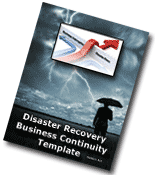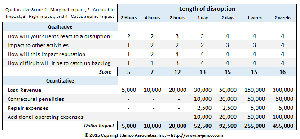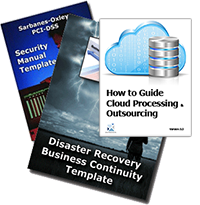The 10 Commandments of Disaster Recovery Business Continuity Planning
Everyone has a disaster recovery and business continuity plan in place. The question is wither it will work when it is needed.
 The 10 commandments and BEST PRACTICES for Disaster Recovery and Business Continuity Planning are:
The 10 commandments and BEST PRACTICES for Disaster Recovery and Business Continuity Planning are:
- Identify and Analyze all single points of failure: A single point of failure in a critical component can disrupt well engineered redundancies and resilience in the rest of a system.
- Keep updated notification trees and alternative methods of communication: A cohesive communication process is required to ensure the disaster recovery business continuity plan will work.
- Be aware of current events both internal and external to the enterprise's 'space': Understand what is happening around the enterprise - know if there is a chance for a weather, sporting or political event that can impact the enterprise's operations.
- Plan for worst-case scenarios: Downtime can have many causes, including operator error, component failure, software failure, and planned downtime as well as building- or city-level disasters.
- Document all recovery processes: Organizations should write and maintain clear, concise, detailed steps for fail-over so that secondary staff members can manage a fail over should primary staff members be unavailable.
- Centralize information and let everyone know where it is at - worry about security: Have a printed copy available: In a crisis situation, a timely response can be critical. Centralizing disaster recovery information in one place, such as a cloud facility, helps avoid the need to hunt for documentation, which can compound a crisis.
- Create test plans and scripts: Test plans and scripts should be created and followed step-by-step to help ensure accurate testing.
- Perform comprehensive recovery and business continuity test: Organizations should practice their master recovery plans, not just application fail over
- Retest regularly: At a minimum, each application should be retested every year.
- Defined metrics and create score cards scores: Organizations should maintain scorecards on the disaster recovery compliance of each application, as well as who is testing and when. Maintaining scorecards generally helps increase audit scores.
Cost of Business Interruption

Click to Enlarge
Order DRP BCP Template DRP BCP Sample
DRP/BCP Tutorial; What is Disaster Recovery?; DRP BCP Basics; ISO 22301 ; ISO 27031; WEB e-commerce Sites; Types of Disasters; Why Plans Fail; Cloud Backup; Are You Prepared for a Disaster?; Pandemic; 10 Commandments of DR & BC Planning; 10 best practices Disaster Recovery Business Continuity, Risk Assessment; Process; Interruption Life Cycle ; Best Practices; Compliance Requirements; Media Communication; Facility Loss; Clean up - How To; Data Center Recovery Strategy;What to do after an explosion, terrorist attack, or random act of violence; Disaster Recovery and Business Continuity; Metrics; Calculating the cost of a Business Interruption; Funding; Funding Request Presentation; Maximum Tolerable Period of Disruption; Disaster Recovery Guide; Common Mistakes; Why Disaster Recovery Business Continuity is not complete and or inaccurate; Disaster Planning Template; Testing Options; Blackouts; Trends impacting DR/BC; 10 point power checklist DR/BC Event Infrastructure




